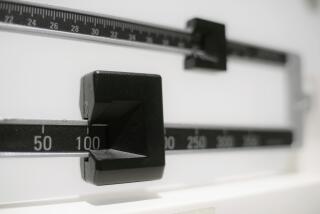Could electrical stimulation to the brain help with weight loss? A new study shows promise
- Share via
Giving a region of the brain that’s key to self-control and motivation a zetz of electrical stimulation may help the obese to eat less and lose more weight, says a new study.
Research suggests that the brains of people who are obese differ in a key respect from those of normal-weight people: The left dorsolateral prefrontal cortex -- a structure just above the right eye that plays a role in behavior related to planning and reward-seeking -- is less active in the obese.
When research subjects are engaged in turning down unhealthy food temptations, this is the region of the brain that lights up with activity.
It may be that underpowered neurons in that region weaken an individual’s will power and lead to problematic consumption and obesity. It may be that excessive weight gain comes first and somehow suppresses activity there. Either way, researchers have wondered whether the left dorsolateral prefrontal cortex might be a key battleground in the fight against obesity.
In a very small and preliminary clinical trial published Wednesday by the journal Obesity and presented at a weeklong meeting of the Obesity Society in Los Angeles, researchers recruited nine obese subjects and asked them to spend nine days in an experimental facility. All the trial participants chose whatever they wanted to eat whenever they wanted to eat it from an automated selection system which kept careful track of their calorie and fat intake.
Just before breakfast on the mornings of days six, seven and eight, participants relaxed and watched nature and history videos while they were hooked up to a transcranial direct current stimulation device. For about 40 minutes, researchers directed either a sham current or a constant stream of electrical current at the left dorsolateral prefrontal cortex.
Transcranial direct current stimulation does not sink electrodes into the brain, but rather sends electrical current through the bones and other tissue to brain regions from patches attached to the skin or scalp. While the treatment has limitations -- it cannot reach some of the brain’s deepest regions -- transcranial stimulation has been found an effective treatment for some with depression, anxiety and chronic pain, and is being explored as a treatment for Parkinson’s disease symptoms.
In one iteration of the study, the researchers directed the electrical signal to areas unlikely to boost activity in the brain’s left dorsolateral prefrontal cortex. In a second iteration, they used a current optimized to increase activation there. In each iteration, four subjects got no current at all, while five received electrical stimulation.
When participants got a sham current, and when they got electrical stimulation directed elsewhere, they consumed between 3,500 and 3,700 calories per day, with fat calories representing between 37.5 and 40% of their daily intake.
When participants got current directed at the left dorsolateral prefrontal cortex, though, they consumed an average of 2,863 calories daily -- a reduction of 18% to 23%. And fat represented a smaller proportion -- 35.6% -- of their daily calories. Daily consumption of calories from soda plunged by as much as 50%, as well. And they lost significantly more weight.
Other studies using transcranial direct current stimulation to the left dorsolateral prefrontal cortex have had effects more muted and varied. Some have resulted in a pronounced reduction in cravings for sweets. Others -- notably studies that used brief or single sessions of electrical current -- failed to effect significant changes in eating behavior.
Longer and more sustained treatment, this study suggests, may be the key to effectiveness. The same goes for research: Larger subject populations and longer interventions will be needed before the effectiveness of this treatment can be proved.
Follow me on Twitter @LATMelissaHealy and “like” Los Angeles Times Science & Health on Facebook.







